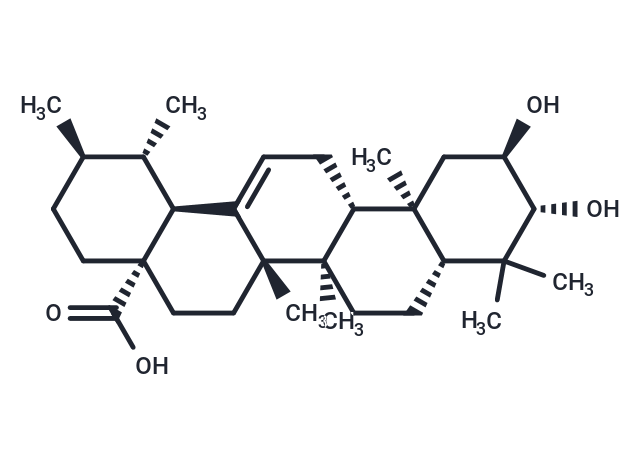Shopping Cart
Remove All Your shopping cart is currently empty
Your shopping cart is currently empty
Corosolic acid (Colosic acid) contains anti-angiogenic activity that can suppress FAK signaling induced by angiopoietin-1. Corosolic acid exerts anticancer activities against HCC, colon, and colorectal Y cells, by inducing apoptosis and promoting the N-terminal phosphorylation and subsequent proteasomal degradation of β-catenin.

| Pack Size | Price | USA Warehouse | Global Warehouse | Quantity |
|---|---|---|---|---|
| 5 mg | $39 | In Stock | In Stock | |
| 10 mg | $59 | In Stock | In Stock | |
| 25 mg | $113 | In Stock | In Stock | |
| 50 mg | $172 | In Stock | In Stock | |
| 100 mg | $255 | In Stock | In Stock | |
| 200 mg | $378 | - | In Stock | |
| 1 mL x 10 mM (in DMSO) | $43 | In Stock | In Stock |
| Description | Corosolic acid (Colosic acid) contains anti-angiogenic activity that can suppress FAK signaling induced by angiopoietin-1. Corosolic acid exerts anticancer activities against HCC, colon, and colorectal Y cells, by inducing apoptosis and promoting the N-terminal phosphorylation and subsequent proteasomal degradation of β-catenin. |
| Synonyms | Glucosol, Corsolic acid, Colosolic acid, Colosic acid, 2α-Hydroxyursolic acid |
| Molecular Weight | 472.70 |
| Formula | C30H48O4 |
| Cas No. | 4547-24-4 |
| Smiles | C[C@@H]1CC[C@@]2(CC[C@]3(C)C(=CC[C@@H]4[C@@]5(C)C[C@@H](O)[C@H](O)C(C)(C)[C@@H]5CC[C@@]34C)[C@@H]2[C@H]1C)C(O)=O |
| Relative Density. | 1.14 g/cm3 |
| Storage | keep away from direct sunlight,keep away from moisture | Powder: -20°C for 3 years | In solvent: -80°C for 1 year | Shipping with blue ice/Shipping at ambient temperature. | |||||||||||||||||||||||||||||||||||
| Solubility Information | DMSO: 125.00 mg/mL (264.44 mM), Sonication is recommended. Chloroform, Dichloromethane, Ethyl Acetate, Acetone, etc.: Soluble | |||||||||||||||||||||||||||||||||||
| In Vivo Formulation | 10% DMSO+40% PEG300+5% Tween 80+45% Saline: 3.30 mg/mL (6.98 mM), Sonication is recommended. Please add the solvents sequentially, clarifying the solution as much as possible before adding the next one. Dissolve by heating and/or sonication if necessary. Working solution is recommended to be prepared and used immediately. The formulation provided above is for reference purposes only. In vivo formulations may vary and should be modified based on specific experimental conditions. | |||||||||||||||||||||||||||||||||||
Solution Preparation Table | ||||||||||||||||||||||||||||||||||||
DMSO
| ||||||||||||||||||||||||||||||||||||
| Size | Quantity | Unit Price | Amount | Operation |
|---|

Copyright © 2015-2026 TargetMol Chemicals Inc. All Rights Reserved.